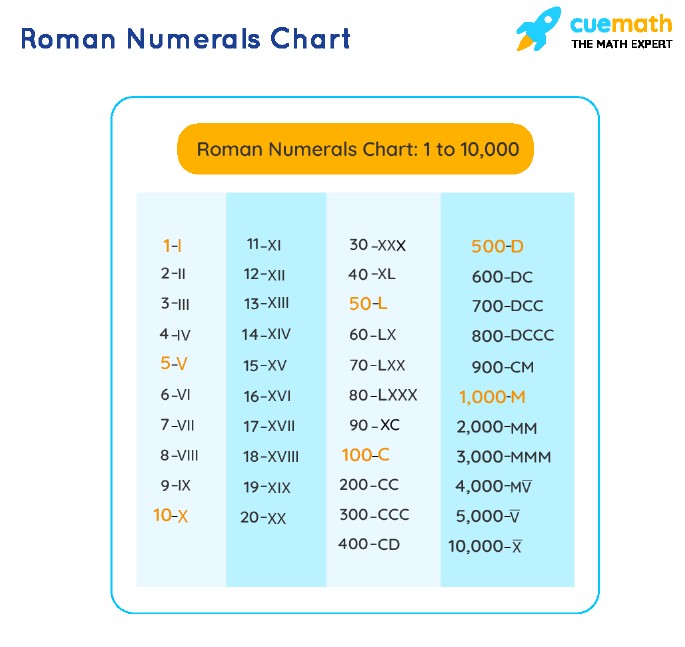Roman numerals are an ancient numbering system that utilizes letters to represent numerical values. While the system might seem complex at first, it is based on a few fundamental symbols. This article dives into the specifics of one such symbol: “L,” exploring its value and its role within the broader Roman numeral system. We’ll cover what a Roman numeral ‘L’ signifies, provide context within the complete Roman numeral chart, and explain the rules governing its usage to enhance understanding.
Understanding the Roman Numeral System
The Roman numeral system employs a set of letters to denote numbers. The most common letters are I, V, X, L, C, D, and M, representing 1, 5, 10, 50, 100, 500, and 1000, respectively. These numerals found applications across various domains, including trade and communication, and are still used today, such as clock faces and numbering systems.
Decoding “L” in Roman Numerals
The Roman numeral “L” stands for the number 50. It’s a crucial component of the system, especially when constructing numbers between 40 and 90. Understanding “L” is key to interpreting and writing Roman numerals accurately.
The Roman Numerals Chart
A Roman numeral chart is helpful for understanding the values of individual numerals and how they combine to form larger numbers. Here’s a simplified chart highlighting the key numerals, including ‘L’:
| Roman Numeral | Value |
|---|---|
| I | 1 |
| V | 5 |
| X | 10 |
| L | 50 |
| C | 100 |
| D | 500 |
| M | 1000 |
 Roman Numerals Chart – Roman numerals list
Roman Numerals Chart – Roman numerals list
Rules Governing Roman Numerals
To accurately use Roman numerals, one must adhere to specific rules. These rules dictate how numerals can be combined to represent different values:
- Addition: When a numeral of lower value follows one of higher value, their values are added (e.g., LX = 50 + 10 = 60).
- Subtraction: If a numeral of lower value precedes one of higher value, the lower value is subtracted from the higher value (e.g., XL = 50 – 10 = 40). Only I, X, and C can be used in subtraction.
- Repetition: A numeral can be repeated up to three times to multiply its value (e.g., XXX = 10 + 10 + 10 = 30). The numerals V, L, and D are never repeated.
- Maximum Repetitions: A numeral cannot be repeated more than three consecutive times. To represent 40, we write XL (50-10), not XXXX.
- Order Matters: The order of numerals is crucial. XL represents 40, while LX represents 60.
Examples Featuring “L”
Let’s look at examples that incorporate the Roman numeral “L”:
- LX: L (50) + X (10) = 60
- LXX: L (50) + X (10) + X (10) = 70
- LXXX: L (50) + X (10) + X (10) + X (10) = 80
- XL: L (50) – X (10) = 40 (Here, X precedes L, indicating subtraction)
These examples illustrate how “L” combines with “X” to represent numbers in the 40 to 80 range, showcasing the subtractive and additive principles of the Roman numeral system.
Converting Numbers to Roman Numerals Using “L”
Converting numbers into Roman numerals involves breaking down the number into components that match the values of Roman numerals.
Example: Convert 85 to a Roman numeral.
- Break down 85 into 50 + 30 + 5.
- 50 = L
- 30 = XXX
- 5 = V
- Combine: L + XXX + V = LXXXV.
Common Mistakes to Avoid
When working with Roman numerals, especially “L,” avoid these common pitfalls:
- Incorrect Subtraction: Ensure that only I, X, and C are used for subtraction. For example, you cannot write 45 as VL; instead, use XLV.
- Exceeding Repetition Limits: Remember that I, X, and C can be repeated up to three times, but V, L, and D cannot be repeated at all.
- Ignoring Order: Pay close attention to the order of numerals, as it determines whether to add or subtract values.
Practical Uses of Roman Numerals
Despite being an ancient system, Roman numerals are still used in various contexts today:
- Clock Faces: Many traditional clocks and watches use Roman numerals to mark the hours.
- Book Chapter Numbers: Roman numerals often denote chapter numbers in books.
- Outlines and Lists: They are used to organize outlines and lists, providing a structured format.
- Building Cornerstones and Monuments: Roman numerals are often inscribed on cornerstones and monuments to indicate the year of construction or dedication.
- Royal Names: Roman numerals distinguish monarchs or popes with the same name (e.g., King Henry VIII).
Conclusion
Understanding “What Is A Roman Numeral L” is a fundamental step in mastering the Roman numeral system. “L” represents 50 and is an essential component when forming numbers, particularly those between 40 and 90. By understanding the rules and principles governing Roman numerals, we can accurately interpret and use this ancient numbering system in various modern contexts. From clock faces to historical inscriptions, Roman numerals continue to be a relevant and fascinating part of our visual and cultural landscape.